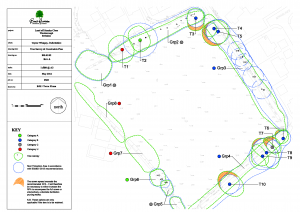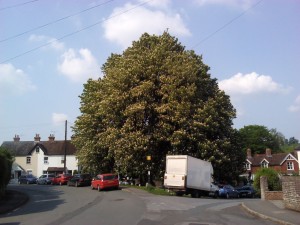Arboriculturist Bernie Harverson who works independently from our offices (but is a frequent Terra Firma sub-consultant) has offered some useful insights into the latest BS on trees; these are inevitably important considerations for landscape architects:
Without much prior warning or pre-issue seminars on 30th April 2012 we in the ‘Arb World’ had British Standard 5837:2012 thrust upon us and for a while there was a mad panic to get our heads around it. Luckily this applied to both public and private sector arboriculturists and thankfully it seems Local Authority tree officers have had the same situation to cope with and most have agreed to a ‘Honeymoon Period’ whilst we all get used to using it.
The primary changes are headlined below:-
- As well as a Topographical Plan of the development site showing all the trees with levels at the tree bases and contours shown to highlight any proposed changes in levels close to trees the BS now recommends that a Soil Assessment is carried out to enable the arb expert to advise on foundation design relative to the soils potential for shrinkage or heave – plus advise on the appropriate choice of tree species for new planting on the site.
- Multi-stemmed trees are to have their Root Protection Areas (RPA’s) calculated in a new way – with all stems at 1.5m measured out on site and the data applied to a complicated mathematical equation in order to derive the RPA.
- The old R grading with a presumption for removal has been replaced by a U for unsuitable for retention – thus opening up debate on whether these trees should be automatically removed.
- With the old C grading there was a presumption to remove if the tree imposed a significant constraint on development – now these trees are to be presumed retained unless there is a very good reason put forward that justifies their removal.
- The previous dangerous and often abused statement that ‘For individual open grown trees only, it may be acceptable to offset the distance by up to 20% in one direction[2005]’ has been removed and no longer applies. This has however been replaced by – ‘..where there is an overriding justification for construction within the RPA, technical solutions might be available that prevent damage to trees.[2012]’
– if it is agreed that this is appropriate then it is then the arb experts task to :-
‘ a) demonstrate that the tree(s) can remain viable and that the area lost to encroachment can be compensated for elsewhere, contiguous with its RPA.
b) propose a series of mitigation measures to improve the soil environment that is used by the tree for growth.[2012]’
- The old Arboricultural Implications Assessment has been re-named the Arboricultural Impact Assessment and the list of matters that are to be covered by this document have been increased significantly with emphasis placed on shading issues; privacy & screening; pressure to prune or fell; seasonal nuisance etc etc.
- The old Tree Constraints Plan has been replaced with the requirement for a plan [which I refer to now as the Tree Retentions & Removals Plan] which shows the tree survey data; root protection data; trees selected for retention; tree to be removed; trees to be pruned & areas for landscaping.
- The old Arboricultural Method Statement is no longer an essential requirement at the planning submission stage although the principles of mitigation measures must be clearly highlighted but can be left as ‘Heads of Terms’ only at this juncture and it is then up to the LPA to Condition the submission of a detailed Method Statement at a later stage – thus presumably speeding up the decision making process and not delaying approvals on schemes.
- Protective Fencing Barriers are still required to be ‘fit for the purpose of excluding construction activity and the default position is still for scaffold framework with supports and driven back stays and weldmesh panels firmly secured to them. However, provision has now been made for two alternative forms of back stay where there is existing hard surfacing or underground obstruction OR a high risk of root damage by driving scaffold posts into the ground.
- The old Ground Protection drawing under Figure 3[2005] has been removed and replaced with wording that describes varying levels of ground protection to suit construction activity for – pedestrian only access; pedestrian operated plant up to 2 tonnes and wheeled or tracked vehicles exceeding 2 tonnes.
- Site Monitoring – there is a significant emphasis on the need for an auditable system of arboricultural site monitoring or direct site supervision of activities close to any RPA’s.
- Permanent Hard Surfacing within RPA’s – this is perhaps the most significant change as far as Architects and indeed Landscape Architects are concerned in that the new recommendations are that – ‘New permanent hard surfacing should not exceed 20% of any existing unsurfaced ground within the RPA.[2012]’
Conclusions
In my opinion in trying to strip down and streamline and speed up the decision making process they have actually made it more arduous and costly.
For the arboricultural experts there will be more time spent out on site collecting the additional data and then more time spent addressing all of the issues which now need to be included in the Arboricultural Impact Assessment report.
For the client the bottom line is that time equals money and the cost of undertaking this extra work will inevitably have to be passed on to the clients.

